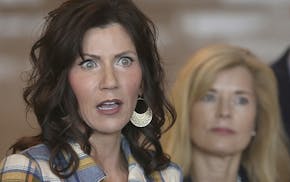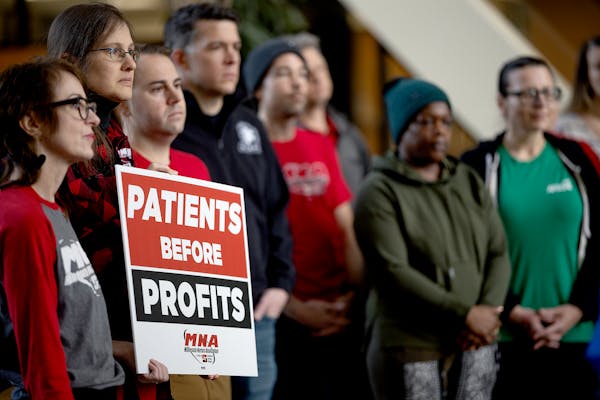Soaring health insurance costs have some public employees questioning whether they can stay in jobs they love but can no longer afford — and public employers scrambling to contain expenses.
Jim Parry said his work with struggling students in the Stewartville, Minn., school district near Rochester is his life's calling. But Parry is not sure how much longer he can keep teaching.
After a new job led to a change in his wife's insurance, Parry had to pick up family health coverage through the district and his insurance costs leapt to about $2,000 a month.
That added expense means he now he works seven days a week, spending his weekends driving a shuttle from Rochester to Minneapolis-St. Paul International Airport for extra money.
"This is the first year I've had to consider whether I can continue teaching," Parry said. "I never thought health insurance would be a major concern."
Public sector jobs, which often pay less than private employers, have long been known for generous benefits. But a growing number of workers at school districts, cities and other public agencies are in Parry's shoes, seeing a once-affordable job perk become a hardship as the cost of health insurance climbs.
Data from KFF, a nonprofit that studies health care costs and policy, shows that while public workers still pay less in premiums on average than those in the private sector, the gap is closing. Last year, public workers paid about 60% what private sector employees paid in premiums for individual coverage; the cost of family coverage had a smaller gap.
However, across Minnesota, not all public workers have access to affordable health insurance.
Lisa Schaefer, human resources director for the League of Minnesota Cities, said costs can fluctuate significantly depending on the size of the group, its claims history and whether it's self-insured. Annual premium increases have been anywhere from single digits to 20% or 30%, she said.
"One of the biggest challenges is that it is very volatile," Schaefer said.
She noted that many local governments have followed the private sector and implemented high-deductible health plans to keep costs in check. Those plans have lower premiums because workers have higher out-of-pocket costs when they need care.
One other perk that still draws workers to the public sector: pensions. Defined benefit retirement plans are increasingly rare in private-sector jobs as employers move workers to savings accounts such as a 401(k). "That's a huge draw," Schaefer said.
Concerns at HCMC
Concerns about workers' rising health care costs have flared in recent months at HCMC and several clinics overseen by Hennepin Healthcare, a nonprofit subsidiary with a $1.5 billion budget approved by the Hennepin County Board. To close a $127 million budget gap, Hennepin Healthcare made changes to employee insurance that leaders described as modest.
Nurses, paramedics and other employees disagreed with that characterization, saying they would see big premium increases for all but the most basic coverage. Some workers said they expect their out-of-pocket costs to grow by 50% — and wonder how those rising costs will affect recruitment and retention at the hospital.
"(Health coverage is) something that's drawn and kept people here for a long time. We've always had above-the-bar coverage," said Shane Hallow, a paramedic and president of the Hennepin County Association of Paramedics and EMTs. "I think we will see an impact organization wide."
In response to caregivers' concerns, the County Board put new restrictions on Hennepin Healthcare's leadership — a move that prompted the resignation of two board members, one of them the incoming president.
County leaders also heard from several groups of other workers, who filed a still-unresolved grievance over insurance administration changes they said would lead to higher costs.
County Administrator David Hough said most workers would pay less under the changes, with pay increases and health savings account contributions offsetting most new costs.
Hough noted that the county pays roughly 90% percent of workers' health care premiums and has an "extremely competitive" benefits package that includes other perks such as tuition reimbursement and a pension. He acknowledged that insurance costs would continue to be a challenge, noting that the county plans for costs to rise as much as 8% annually.
"When you have a large workforce there is always going to be that unpredictability," Hough said.
Some school districts hit hard
In 2022, the Plainview-Elgin-Millville district outside Rochester, where Angie Matiash teaches junior high, shared some difficult insurance news. The Public Employees Insurance Program (PEIP) that the district had joined to keep health care costs down was hiking rates by about 50%.
The increase was unexpected, considering the district joined the PEIP cooperative to insulate teachers from big insurance spikes. Matiash's district was one of several small districts that faced daunting cost increases; some left the program.
State officials who oversee PEIP said state law allows groups to come and go from the cooperative and many leave if they can get lower-cost insurance elsewhere. But fluctuations in the size of the insurance pool mean other groups can see more volatile changes in their costs.
"It doesn't feel like a benefit anymore," said Matiash, who covers a family of six and saw total costs jump $3,000 in the past year. "Health insurance costs are going to start pushing good people out of the profession."
Denise Specht, president of Education Minnesota, the state teachers union, agrees. She and other advocates for public workers want the state Legislature to step in to help keep costs down.
"It's becoming a recruitment and retention issue," Specht said, noting an ongoing shortage of teachers in some specialties. "It's an issue across the state. We've had Band-Aids for years. It's time for a permanent solution."
State plan looks for balance
Still, the benefits packages for many public jobs remain desirable to job seekers, including many who braved frigid temperatures to visit the One Minnesota Career Fair in St. Paul earlier this month. The state is looking to hire thousands of workers after the DFL-led Legislature approved a $70.5 billion two-year budget in May.
Tiya Nelson of Bloomington is a student and IT professional looking for good benefits and upward mobility. That makes the state an attractive place to work, she said.
"It's somewhere I could stay for 20 years; there's a pension and great health insurance," Nelson said at the job fair.
It's an impression that didn't happen by accident. Minnesota is easily the state's largest government employer with more than 38,000 workers in state agencies. Leaders routinely highlight the generous benefit options.
"We have to set ourselves apart as an employer of choice," said Blake Chaffee, deputy commissioner of enterprise employee resources for Minnesota Management and Budget. "Employee benefits, especially health insurance, is one of our biggest pitches to employees."
A recent promotional flier for the Minnesota Advantage Health Plan says state workers pay about one-third the premium that employees of private companies pay. The cost of family coverage is about half.
Galen Benshoof, enterprise director of employee insurance for Minnesota Management and Budget, said the state works hard to keep costs down and its sheer size provides some advantages. Among its strategies: requiring employees to choose a primary clinic and get referrals for specialty care.
Benshoof said he thinks the state's approach can be a model for how other employers can control costs.
"I do think, in general, employers need to do something different than what they've done before," he said.

DFL Sen. Nicole Mitchell returns to Capitol after burglary charge, casts votes amid criticism
Police now say all 5 women have so far survived rollover of SUV exiting I-94 in Minneapolis

Brooks: Kristi Noem's tale of killing her dog backfires

Defense attorneys in first Feeding Our Future trial say defendants served 'real food'

